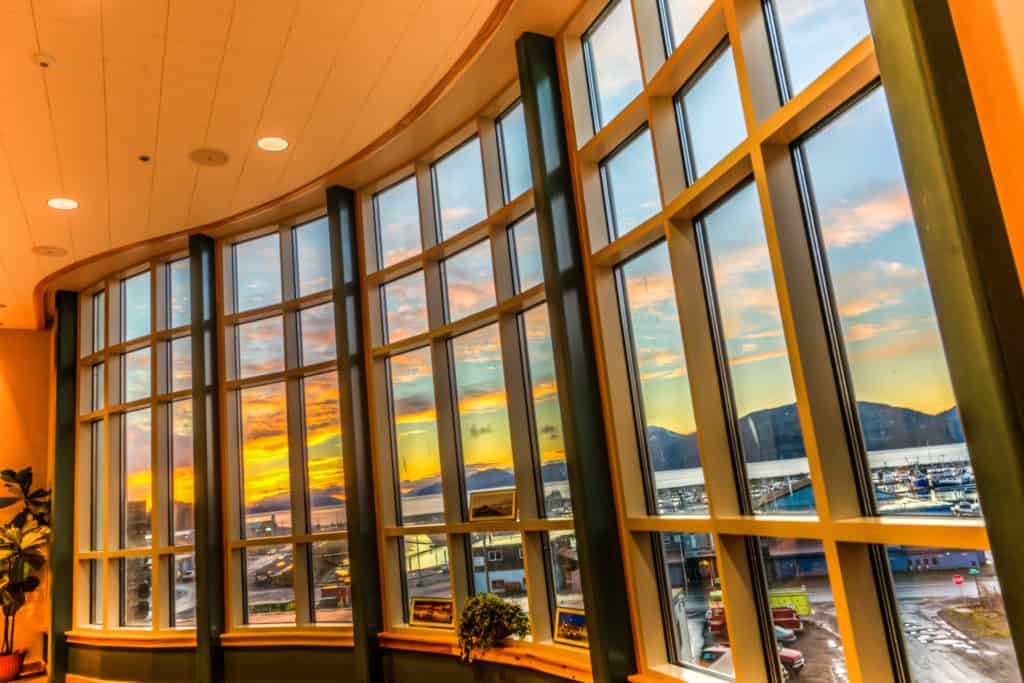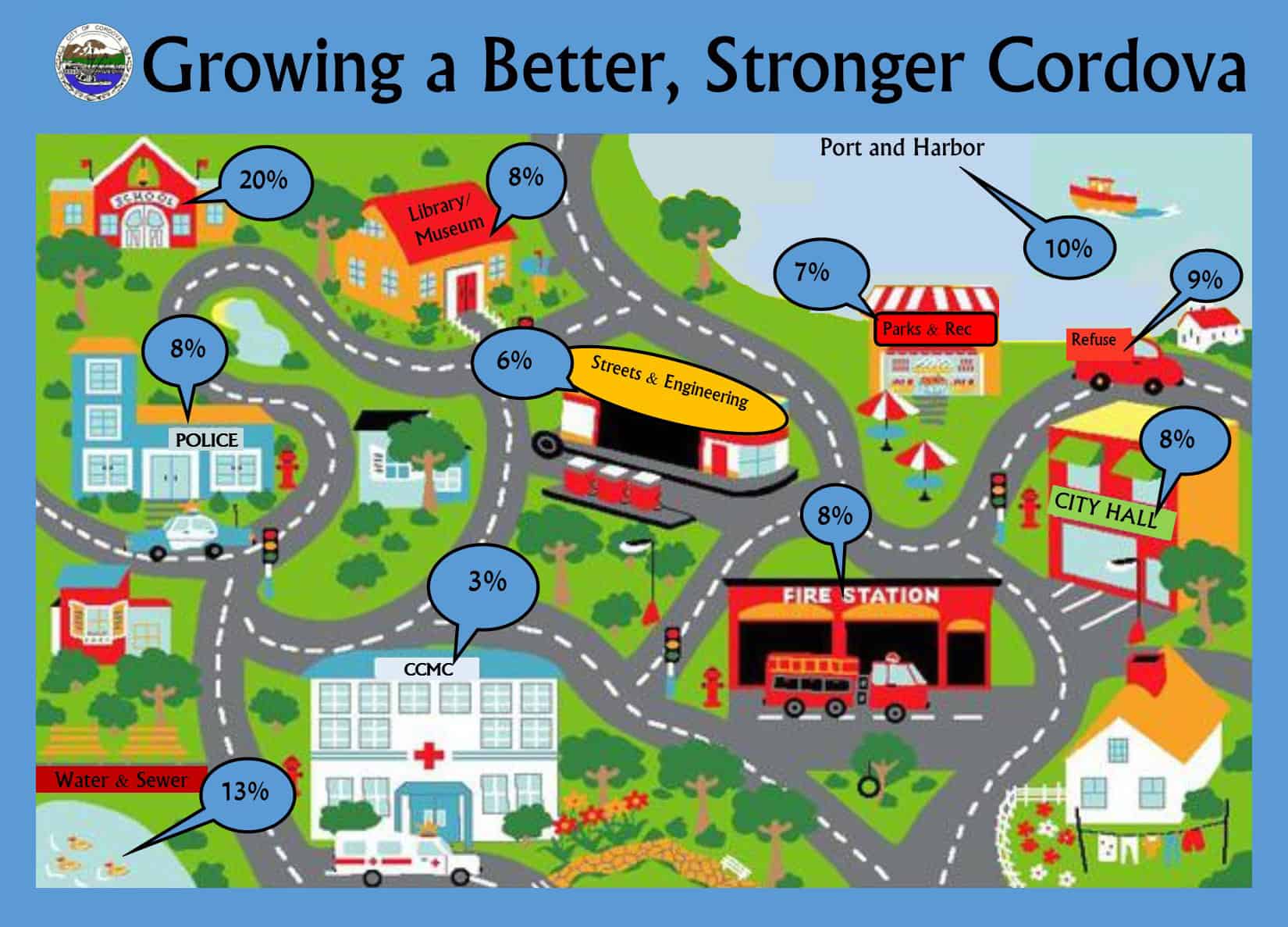What Do City Services Cost?

Where does the money go?
Ever wonder where your city tax dollars and other charges go? Below is a brief snapshot of Cordova’s 2015 budgetary expenditures based on percentages by various activities or functions. Cordova municipal government provides our community with eleven main services covering activities ranging from road and maintenance work to waste collection; production and delivery of safe water; parks and recreational activities; fire/police and emergency management services; museum, library and art events; animal control; financial, billing and investment services; youth programing, and even direct support to the Cordova Community Medical Center. We hope this chart provides you with a better understanding and appreciation of our efforts to be good stewards of our resources. Now we begin to look to the future to provide even more for Cordova through the opening of the Cordova Center.

Your Parks
Managed open spaces and recreational sites enhance quality of life by connecting us to the area in which we live. They provide clean and safe areas to congregate together – or get away from it all. You may not know it, but the City’s Parks Maintenance Division (one permanent employee) tends to 15 separate properties (and 8 pet-waste stations around town to help keep the public areas clean!)
During the summer, daily rounds cover 14 miles of property and take between 2-5 hours each day. The rotation occurs 5-6 days a week and most holidays. From cleaning BBQ Grills and the woodstove at Skater’s Cabin, to emptying trash cans and refilling pet waste bags, to cutting brush and caring for the flowers. How about the fish cleaning station, or the four public bathrooms, two outhouses and Odiak showers? Did you know that the Division also reads the meters at Odiak Camper Park and enforces the rental agreement guidelines at both RV Parks?
The winter is no time to slack off with 3 properties tended to on a daily basis and others rotating two per week. Snow removal is a significant task, taking 4 hours if it only snows once during the day. If it continues to snow, the rounds continue until the end of the work day.
The Division spends an average of 25.5 hours per week maintaining the pool and 16 hours per week performing maintenance at Bidarki. These hours don’t even include the big projects like resurfacing the gym floor, boiler maintenance, and winterizing the outdoor facilities!
Obviously, there’s more work than can be done by one. Temps, volunteers, and teammates all pitch in to make sure our parks and facilities are a great asset. See where your money goes – get outdoors and check out all of the City’s 15 managed properties. While you out looking, be sure to say hello to the Parks and Rec team!
Safe Drinking Water
One of the Water Division’s responsibilities is providing safe drinking water. In a climate such as ours, you’d think that water would be readily available. However, what you may not realize is that too much rain is a bad thing – in fact, during the fl ood advisories for Sept 6th, Cordova nearly ran out of water!
Huh? Well, when it rains, it provides our three water sources (Orca, Murcheson, & Meals/Heney) ample amounts of water – but that water needs to meet EPA guidelines to be useable. For you scientists, turbidity is one important factor – the measure of relative clarity of a liquid. Controlling turbidity is a required safeguard against pathogens in our drinking water. When it rains hard, sediment is stirred up in our water sources, raising the turbidity beyond safe levels. When that happens, our automatic monitoring systems shut down those water sources and supply residents from our water storage tanks.
That is exactly what happened on the 6th. Working quickly to ensure we had access to safe water, five personnel worked day and night to clean out fi lter baskets and slow the fl ow at our sources as well as manually adjusting chlorine applications to meet disinfection standards associated with the different turbidity levels. If the situation grows beyond the ability of staff to handle, they have to spin up the pumps at the Eyak Filter Plant and switch to Lake water – a costly response due to the electricity needed to power the pumps. Last time the pumps were run, the cost to provide water increased by an average of $10,000 per day! Fortunately, the pumps were not needed this time.
To sum it up, rain is helpful, too much rain is costly.
The Harbor, an Enterprise Fund
Does your money actually go to the Harbor? Sort of.
Unlike some City assets, our Port and Harbor is managed as an “Enterprise Fund”. Simply put, an enterprise fund is a separate accounting system used when a fee is charged in exchange for services. By state law, an enterprise fund may be established for a utility, health care, recreation, or transportation facility. As an enterprise fund, Port and Harbor revenues are separated from other city government services. This allows the City to be able to demonstrate to the public that Port and Harbor facilities are self-sustaining.
What it means for Cordova residents is that “we” do not pay the Harbormaster’s salary – nor do “we” pay for the Harbormaster’s office, the docks, floats, or ramps. Who does? The users. Okay, as a fishing town, most of us are both part of “we” and “the users”, however, it is an important distinction to make. Property taxes, sales taxes, and other City revenue that all of us as residents generally contribute do not impact our Port and Harbor. The only revenue that funds our Port and Harbor are Port and Harbor fees. That’s it. Moorage, launch, TravelLift, parking – the user fees are what keep our Port and Harbor staffed, maintained, and operating. Any improvements made in the Port and Harbor are paid for by those same user fees. On good years, when collected user fees are greater than the cost of operating the Port and Harbor, we have opportunities to grow.
A self-sustaining entity, it is our Port and Harbor users that keep it running day-to-day and position Cordova for the future by funding harbor-related economic development initiatives with their user fees.
Our Streets
The Streets Department assesses the condition of each road, the life expectancy of the current surface, and the rate of use to determine the priority of road repairs. Repairs include patching or chip sealing to preserve them. The work being done now is maintenance only; no street replacement is scheduled even though it is sorely needed. Public Works is hoping to budget for some paving next year in conjunction with the Whitshed project, but at almost $500,000 per mile, it is an expensive task.
You may have seen the street crews out working on the potholes around town. The photos show the crew out on Friday, August 30th, our last really nice day. When the weather broke, every available hand from all departments dropped their current tasks and priorities to help out. There was a total of 8 people getting as much done as possible before the weather turned again. The crews used three pieces of equipment – a sweeper, a grader, and a loader. All three are well past the 10-20 year life expectancy, and average 30 years old. They each burn approximately 5 gallons of fuel an hour and require a little heavy lifting from our maintenance shop to keep them running. From a fi nancial standpoint, the assets are depreciated off our books over time, however, the City still needs to maintain insurance coverage on them as long as they are in use.
Could we do better? You bet! Paving all of the City’s 14.6 miles of road surfaces would certainly be an improvement. Is it reasonable, given the cost? New equipment would likely be more fuel effi cient, require less maintenance, and allow for asset depreciation – however, the fi nancial investment is a huge consideration for a community this size. A new sweeper is $150,000, a loader is $350,000 and a grader is $375,000. In the big picture, even a small project like this reflects big financial considerations.
